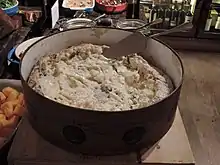Gorgonzola
Gorgonzola (/ˌɡɔːrɡənˈzoʊlə/; Italian pronunciation: [ɡorɡonˈdzɔːla]) is a veined blue cheese, originally from Italy, made from unskimmed cow's milk. It can be buttery or firm, crumbly and quite salty, with a "bite" from its blue veining.[2]
| Gorgonzola | |
|---|---|
 Gorgonzola cheese | |
| Country of origin | Italy |
| Region, town | Gorgonzola |
| Source of milk | Cow |
| Pasteurized | Yes |
| Texture | Soft and crumbly |
| Fat content | 25-35% |
| Aging time | 3–4 months |
| Certification | Italy: DOC from 1955; EU: PDO from 1996[1] |
History
Historically, gorgonzola has been produced for centuries in Gorgonzola, Milan, acquiring its greenish-blue marbling in the 11th century. However, the town's claim of geographical origin is disputed by other localities.[3]
Production
Today, gorgonzola is produced worldwide, with high concentrations of production located in the northern Italian regions of Piedmont and Lombardy, as well as production in the United States.[4] Whole cow's milk is used, to which starter bacteria are added with spores of the mold Penicillium glaucum. The whey is then removed during curdling, and the result aged at low temperatures.

During the ageing process, metal rods are quickly inserted and removed, creating air channels that allow the mold spores to grow into hyphae and cause the cheese's characteristic veining. Gorgonzola is typically aged for three to four months. The length of the ageing process determines the consistency of the cheese, which gets firmer as it ripens. There are two varieties of Gorgonzola, which differ mainly in their age: the less aged Gorgonzola Dolce (also called Sweet Gorgonzola) and the more aged Gorgonzola Piccante (also called Gorgonzola Naturale, Gorgonzola Montagna, or Mountain Gorgonzola).
The United States Food and Drug Administration has established what are known as standards of identity (SOIs). SOIs establish the common name for a food and define the basic nature of that food and its ingredients. The US Code of Federal Regulations Title 21--FOOD AND DRUGS, CHAPTER I--FOOD AND DRUG ADMINISTRATION, SUBCHAPTER B--FOOD FOR HUMAN CONSUMPTION establishes the production process of “gorgonzola” cheese. This SOI, in addition to establishing “gorgonzola” as the product name for this type of cheese for production in the United States, would also apply to any “gorgonzola” cheese imported from non-United States countries.[5]
Protected designation of origin
Under EU law, Gorgonzola enjoys Protected Geographical Status. Termed DOP in Italy, this means that gorgonzola sold in the European Union can only be produced in the provinces of Novara, Bergamo, Brescia, Como, Cremona, Cuneo, Lecco, Lodi, Milan, Pavia, Varese, Verbano-Cusio-Ossola and Vercelli, as well as a number of comuni in the area of Casale Monferrato (province of Alessandria). Over time, production of the cheese beyond the historic geographic production area has led to the genericization of the term “gorgonzola”. Gorgonzola has been determined to be a generic term in legal systems around the world, including Australia where it was ruled that the term “gorgonzola” is generic.[6]
Consumption
Gorgonzola may be eaten in many ways, as all blue cheeses. It is often added to salads, either straight or as part of a blue cheese dressing. Combined with other soft cheeses it is an ingredient of pizza ai quattro formaggi (four-cheese pizza). It is often used as a topping for steak, sometimes in the form of a sauce with Port or other sweet wine. It may be melted into a risotto in the final stage of cooking, or served alongside polenta.
Nutrition is as follows: 1 ounce (28 grams) of gorgonzola contains 100 calories, 9 g of fat, 375 mg of sodium, 1 g of carbohydrate and 6 g of protein. It contains 5.3 g of saturated fat.
In popular culture
James Joyce, in his 1922 Ulysses, gives his hero Bloom a lunch of "a glass of Burgundy and a Gorgonzola sandwich". In his 1972 book Ulysses on the Liffey, critic and Joyce scholar Richard Ellmann suggests that "Besides serving as a parable that life breeds corruption, Gorgonzola is probably chosen also because of Dante's adventures with the Gorgon in the Inferno IX. Bloom masters the monster by digesting her."[7]
References
- "Gorgonzola" (in Italian). Archived from the original on 2004-11-15. Retrieved 2013-03-01.
- "Gorgonzola DOP". BuonaLombardia. Regione Lombardia. 18 March 2020. Retrieved 5 April 2020.
- Helm-Ropelato, Rebecca (2 February 2005). "The birthplace of Gorgonzola. Maybe". The Christian Science Monitor. Boston MA.
- "Gorgonzola".
- "CFR - Code of Federal Regulations Title 21". www.accessdata.fda.gov. Retrieved 2020-12-14.
- US Dairy Export Council v Consorzio Per La Tutela Del Formaggio Gorgonzola, 2020-03-24, retrieved 2020-12-14
- Richard Ellmann (1972). Ulysses on the Liffey. Oxford University Press. p. 191. ISBN 978-0-19-972912-8.
External links
| Wikimedia Commons has media related to Gorgonzola (cheese). |